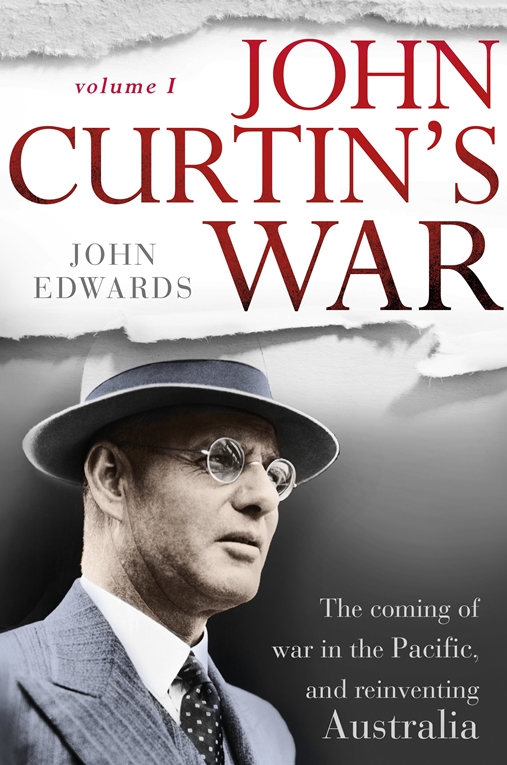What was the purpose of the book? John Curtin’s War is an examination of events about ‘an obscure politician from Perth’ (p. 321) who had left school at fourteen, was good at arithmetic, smoked Craven ‘As’, liked Irish stew, could type with two fingers, went on picnics and became Prime Minister in most extra-ordinary, difficult and challenging times. Eminent persons, from both sides of the political fence, have engaged in verbal fisticuffs about the ‘correct’ interpretation of certain events which took place during WW II, mainly to do with Churchill, but this review does not directly address the political context, rather considers ‘John Curtin’s War’ both as an analytical narrative and a literary work of art. Early chapters cover Curtin’s life in Melbourne, his move to WA where, after four attempts, he is finally elected ALP member for Fremantle on 15 September 1934.

Hardcover 538pp RRP: $49.99
Edwards addresses the effects of the Depression, WA’s move to secede from the Commonwealth, and refers to well-known Perth identities: Alec Reid, Chancellor, University of WA; Jimmy Mitchell, Lieutenant Governor; and Senator Bertie Johnston; people who were public figures in WA’s inter-war period. Curtin spoke about defence and foreign policy issues, 5 November 1936, and the Singapore strategy that was already doomed to failure. The ALP was expected to be more concerned with trade union matters rather than defence and foreign policy. Events in Europe – Menzies’ trip to London for the Silver Jubilee of King George V, anschluss, the Czechoslovak crisis of late 1938, Lord Halifax and the appeasers, the talk of Japanese southward expansion (which seemed strange since Japan had been an ‘ally’) are all covered in a fascinating and detailed way. During WW I Japanese destroyers had escorted Australian troops en route in the Mediterranean, and two Japanese battle cruisers, ‘Nisshin’ and ‘Ibuki’ were scheduled to escort the 27 Australian and 10 NZ troop transports from Albany on 1st November 1914. When the convoy did sail from Albany, only ‘Ibuki’ joined up with ‘Sydney’, ‘Melbourne’ and ‘Minotaur’.
Yet 21 years later, Curtin saw the situation differently, the RN would not be coming to Singapore and Australia would be on its own. We are given insights into the political intrigues of the late 1930s; the roles played by R.G. Menzies, Stanley Bruce, Joe Lyons, Jack Lang, Earle Page, Richard Casey, Eddie Ward, Sir Ronald Cross, Douglas MacArthur, and in particular the significant role of public servant, Frederick Shedden. These are spelt out, sometimes in unflattering prose. An interesting aside, is the personal relationship between Menzies and Curtin; courteous, polite, restrained – so different from the Canberra of recent times. The relationship between Churchill and Curtin is portrayed in a very different style. Churchill is described as ‘indignant, grumbling and irritated’ in his correspondence with Curtin, characteristics which are evident in Churchill’s six volume ‘The Second World War’. Probably, Churchill had good reason to be annoyed. After all, he did have an empire to protect, was running a war on several fronts viz. the Atlantic, the Middle East, Malaya/Singapore and the Home Front. John Curtin, prime minister of a country of but seven million and in reality, a long way from the action was really a distraction and side issue. No wonder then that reports got back to Churchill that the Australians were panicking. British High Commissioner, Sir Ronald Cross, hitherto relatively unknown, comes across in a most interesting way. Curtin did not (unsurprisingly) get on with Cross (later to become Governor of Tasmania).
The concluding chapters cover Singapore, the possibility of Japanese invasion and a thawing in the frosty relationship with Churchill: as Edwards points out, they were both politicians and needed each other.
What approach or methodology was adopted? John Curtin’s War is a biography, an analytical narrative and much else besides. The charm of this so-revealing text lies in Edwards’ mastery and use of prose composition: it is simply flawless. While much of the over-all story is probably known, it is in the detail of events and people that is captivating. The political drama of the 1930s, the Perth/Cottlesloe lifestyle, the overnight WAGR rattler to Kalgoorlie (the wild life in the Perth foothills, the compulsory morning tea and two biscuits after a sleepless night) and then the monotony/relaxation of a long trip to Canberra, are all presented in exquisite detail. Events moved fast for Curtin, Menzies declaring, to his ‘Fellow Australians’ at 9.15pm Sunday 3 September, 1939, that it was his melancholy duty to declare war; Street, Fairbairn, Gullett and White killed in plane crash 13 August, 1940; Menzies’ return to Australia, 24 May, 1941; and Curtin, then aged 56, telling his wife he has a birthday gift for her, 3 October, 1941 – his new cabinet met 7 October, 1941. With the loss of HMAS Sydney, 19 November 1941 Curtin remained calm and in control.
Edwards describes Curtin as a loner, appointed rather than elected, but with moral authority that becomes clear in the text.
What is original/new? What is the value? Edwards writes (p. 348) ‘No Australian prime minister had ever overseen the doing of so much, so quickly’. This sentence sums up Curtin’s achievements in such difficult and dangerous circumstances. John Curtin (1885-1945) died in office on 4 July 1945 aged 60 years.
Including photographs, endnotes, a bibliography, acknowledgements, and an index, this is a great story about a great man − the former trade union official and radical socialist, who guided Australia through its most difficult period as its 14th Prime Minister.
Reviewed for RUSIV by Michael Small, January 2018.
Go to John Curtin’s War Vol II, Triumph and Decline by John Edwards – Book Review
Contact Royal United Services Institute about this article.






